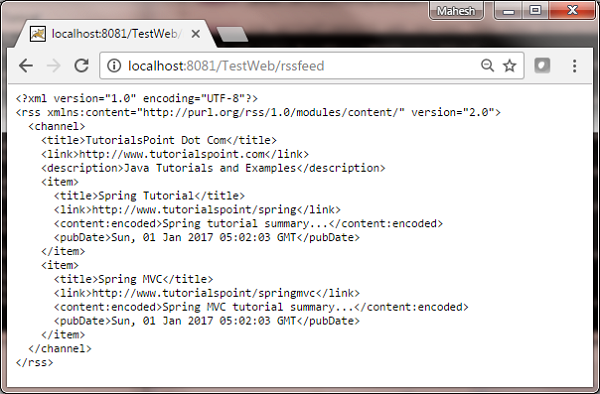Spring MVC - пример создания RSS-канала
В следующем примере показано, как создать RSS-канал с помощью Spring Web MVC Framework. Для начала давайте создадим рабочую среду IDE Eclipse, а затем рассмотрим следующие шаги по разработке веб-приложения на основе динамической формы с использованием Spring Web Framework.
| Шаг | Описание |
|---|---|
| 1 | Создайте проект с именем TestWeb в пакете com.tutorialspoint, как описано в главе Spring MVC - Hello World. |
| 2 | Создайте классы Java RSSMessage, RSSFeedViewer и RSSController в пакете com.tutorialspoint. |
| 3 | Загрузите римскую библиотеку Rome и ее зависимости rome-utils, jdom и slf4j с той же страницы репозитория maven. Поместите их в свой КЛАСС. |
| 4 | Создайте файл свойств messages.properties в папке SRC. |
| 5 | Последний шаг - создать содержимое исходных файлов и файлов конфигурации и экспортировать приложение, как описано ниже. |
RSSMessage.java
package com.tutorialspoint;
import java.util.Date;
public class RSSMessage {
String title;
String url;
String summary;
Date createdDate;
public String getTitle() {
return title;
}
public void setTitle(String title) {
this.title = title;
}
public String getUrl() {
return url;
}
public void setUrl(String url) {
this.url = url;
}
public String getSummary() {
return summary;
}
public void setSummary(String summary) {
this.summary = summary;
}
public Date getCreatedDate() {
return createdDate;
}
public void setCreatedDate(Date createdDate) {
this.createdDate = createdDate;
}
}RSSFeedViewer.java
package com.tutorialspoint;
import java.util.ArrayList;
import java.util.List;
import java.util.Map;
import javax.servlet.http.HttpServletRequest;
import javax.servlet.http.HttpServletResponse;
import org.springframework.web.servlet.view.feed.AbstractRssFeedView;
import com.rometools.rome.feed.rss.Channel;
import com.rometools.rome.feed.rss.Content;
import com.rometools.rome.feed.rss.Item;
public class RSSFeedViewer extends AbstractRssFeedView {
@Override
protected void buildFeedMetadata(Map<String, Object> model, Channel feed,
HttpServletRequest request) {
feed.setTitle("TutorialsPoint Dot Com");
feed.setDescription("Java Tutorials and Examples");
feed.setLink("http://www.tutorialspoint.com");
super.buildFeedMetadata(model, feed, request);
}
@Override
protected List<Item> buildFeedItems(Map<String, Object> model,
HttpServletRequest request, HttpServletResponse response) throws Exception {
List<RSSMessage> listContent = (List<RSSMessage>) model.get("feedContent");
List<Item> items = new ArrayList<Item>(listContent.size());
for(RSSMessage tempContent : listContent ){
Item item = new Item();
Content content = new Content();
content.setValue(tempContent.getSummary());
item.setContent(content);
item.setTitle(tempContent.getTitle());
item.setLink(tempContent.getUrl());
item.setPubDate(tempContent.getCreatedDate());
items.add(item);
}
return items;
}
}RSSController.java
package com.tutorialspoint;
import java.util.ArrayList;
import java.util.Date;
import java.util.List;
import org.springframework.stereotype.Controller;
import org.springframework.web.bind.annotation.RequestMapping;
import org.springframework.web.bind.annotation.RequestMethod;
import org.springframework.web.servlet.ModelAndView;
@Controller
public class RSSController {
@RequestMapping(value="/rssfeed", method = RequestMethod.GET)
public ModelAndView getFeedInRss() {
List<RSSMessage> items = new ArrayList<RSSMessage>();
RSSMessage content = new RSSMessage();
content.setTitle("Spring Tutorial");
content.setUrl("http://www.tutorialspoint/spring");
content.setSummary("Spring tutorial summary...");
content.setCreatedDate(new Date());
items.add(content);
RSSMessage content2 = new RSSMessage();
content2.setTitle("Spring MVC");
content2.setUrl("http://www.tutorialspoint/springmvc");
content2.setSummary("Spring MVC tutorial summary...");
content2.setCreatedDate(new Date());
items.add(content2);
ModelAndView mav = new ModelAndView();
mav.setViewName("rssViewer");
mav.addObject("feedContent", items);
return mav;
}
}TestWeb-servlet.xml
<beans xmlns = "http://www.springframework.org/schema/beans"
xmlns:context = "http://www.springframework.org/schema/context"
xmlns:xsi = "http://www.w3.org/2001/XMLSchema-instance"
xsi:schemaLocation = "
http://www.springframework.org/schema/beans
http://www.springframework.org/schema/beans/spring-beans-3.0.xsd
http://www.springframework.org/schema/context
http://www.springframework.org/schema/context/spring-context-3.0.xsd">
<context:component-scan base-package = "com.tutorialspoint" />
<bean class = "org.springframework.web.servlet.view.BeanNameViewResolver" />
<bean id = "rssViewer" class = "com.tutorialspoint.RSSFeedViewer" />
</beans>Здесь мы создали RSS-канал POJO RSSMessage и Средство просмотра RSS-сообщений, которое расширяет возможности AbstractRssFeedViewи отменяет свой метод. В RSSController мы создали образец RSS-канала.
Как только вы закончите создание исходных файлов и файлов конфигурации, экспортируйте свое приложение. Щелкните правой кнопкой мыши свое приложение, используйтеExport → WAR File вариант и сохраните TestWeb.war в папке webapps Tomcat.
Теперь запустите сервер Tomcat и убедитесь, что у вас есть доступ к другим веб-страницам из папки webapps с помощью стандартного браузера. Попробуйте URL-адрес -http://localhost:8080/TestWeb/rssfeed и мы увидим следующий экран.
